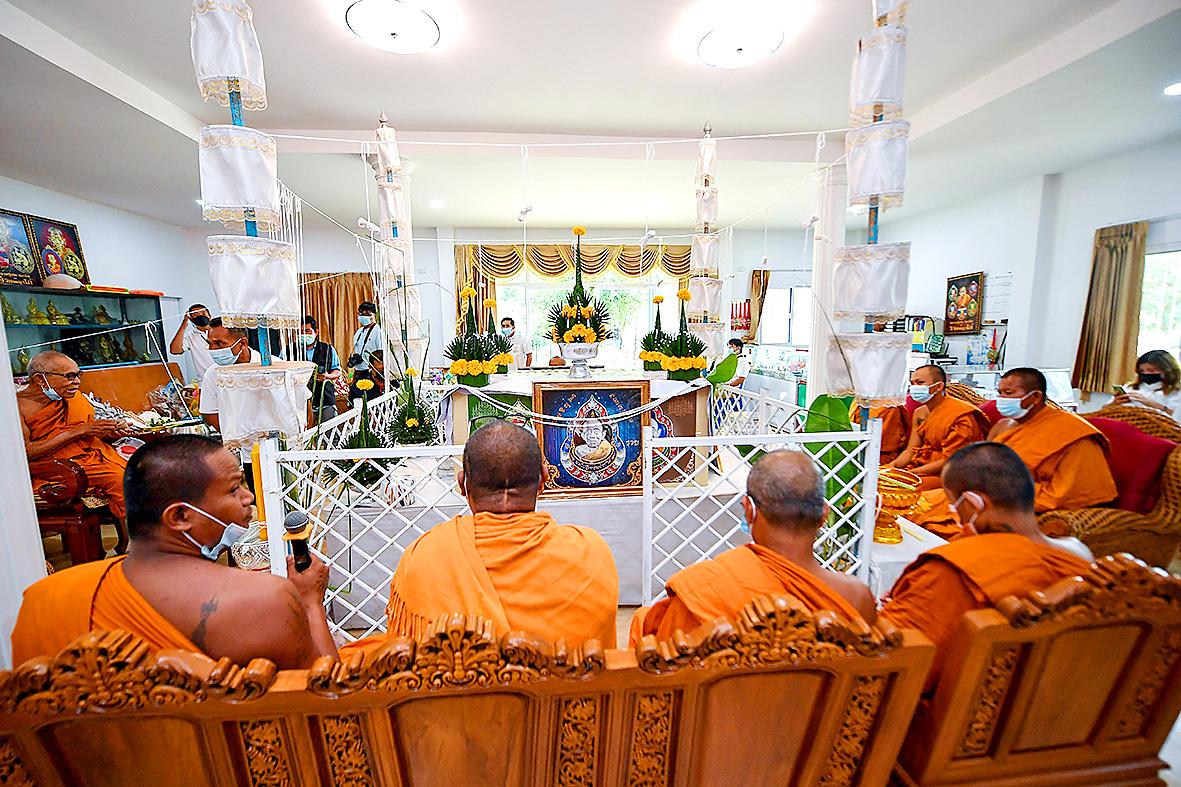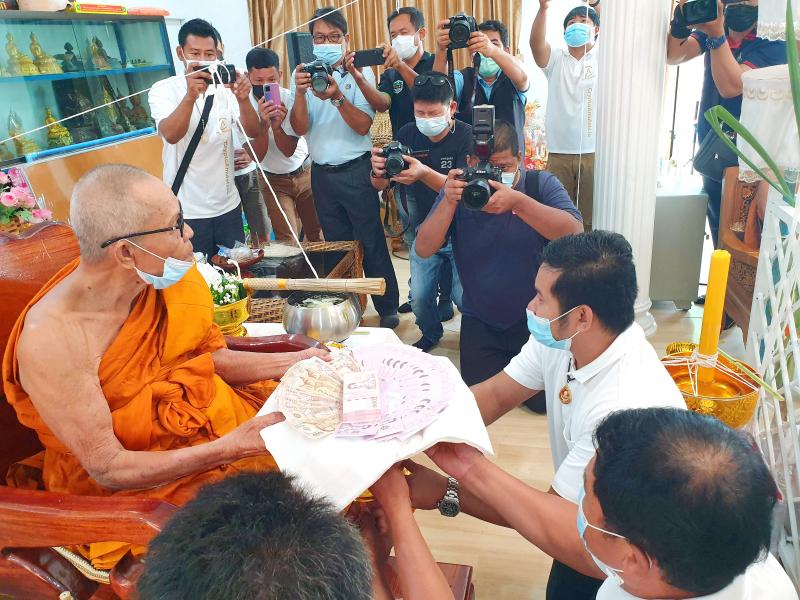Karmic fortune has arrived to the digital art market, with a kaleidoscopic splash of colors and the face of a revered Thai monk offering portable Buddhist good luck charms to tech-savvy buyers.
Sales of non-fungible tokens (NFTs) — virtual images of anything from popular internet memes to original artwork — have swept the art world in recent months, with some fetching millions of dollars at major auction houses. “CryptoAmulets” is the latest venture to chase the craze, with founder Ekkaphong Khemthong sensing opportunity in Thailand’s widespread practice of collecting talismans blessed by revered monks.
“I am an amulet collector and I was thinking about how I could introduce amulets to foreigners and to the world,” he said.

Photo: AFP
Collecting amulets and other small religious trinkets is a popular pastime in Buddhist-majority Thailand, where the capital Bangkok has a market solely dedicated to the traders of these lucky objects.
Their value can rise thousands of dollars if blessed by a well-respected monk.
Despite being a digital format, Ekkapong wanted CryptoAmulets to have the same traditional ceremony as a physical piece, which is why he approached Luang Pu Heng, a highly regarded abbot from Thailand’s northeast.

Photo: AFP
“I respect this monk and I would love the world to know about him — he is a symbol of good fortune in business,” he said.
AUTHENTIC AND BLESSED
Luang Pu Heng last month presided over a ceremony to bless physical replicas of the digital amulets, which show a serene image of his face.

Photo: AFP
He splashed holy water onto his own visage as his saffron-robed disciples chanted and scattered yellow petals on the altar where the portraits were mounted. One challenge was trying to explain the concept of NFTs to the 95-year-old abbot, who assumed he would be blessing physical amulets.
“It’s very hard so we just tried to simplify it,” said Singaporean developer Daye Chan. “We said to him that it’s like blessing the photos.”
Transforming amulets into crypto art also means the usual questions of authenticity plaguing a talisman sold in a market are eliminated, he added.
“There are so many amulets being mass produced... All the records could be lost and these physical items can be easily counterfeited,” Chan said.
NFTs use blockchain technology — an unalterable digital ledger — to record all transactions from the the moment of their creation.
“For our amulet, even a hundred years later, they can still check back the record to see what the blockchain is,” Chan said.
But founder Ekkaphong would not be drawn on the karmic effectiveness of digital amulets, compared to their real-life counterparts. “They are different,” he said.
‘LUCKY EXPERIENCES’
On the CryptoAmulets Web site online gallery, different inscriptions are written in Thai — “rich”, “lucky” or “fortunate”, for instance — around each of the tokens.
They are priced on a tiered system in ethereum, the world’s second-largest cryptocurrency after bitcoin, and are currently selling for between US$46 and US$1,840. Sales have been slow ahead of Sunday’s purchase deadline, with only 1,500 tokens sold out of the 8,000 available, and with Thais making up most of the buyers.
Thai chef Theerapong Lertsongkram said he bought a CryptoAmulet because of his reverence for objects blessed by Luang Pu Heng, which he says have brought him good fortune.
“I have had several lucky experiences such as winning small lottery prizes... or being promoted on my job,” said Theerapong, who works in a Stockholm restaurant.
“I did not know anything about NFTs before, but I made the decision to buy it as I respect Luang Pu Heng so much,” he said.
But fellow collector Wasan Sukjit — who adorns the interior of his taxi with rare amulets — has a harder time with the concept. “Amulets need to be something physical, something people can hold,” he scoffed. “I prefer the ones I can hang on my neck.”

Oct. 27 to Nov. 2 Over a breakfast of soymilk and fried dough costing less than NT$400, seven officials and engineers agreed on a NT$400 million plan — unaware that it would mark the beginning of Taiwan’s semiconductor empire. It was a cold February morning in 1974. Gathered at the unassuming shop were Economics minister Sun Yun-hsuan (孫運璿), director-general of Transportation and Communications Kao Yu-shu (高玉樹), Industrial Technology Research Institute (ITRI) president Wang Chao-chen (王兆振), Telecommunications Laboratories director Kang Pao-huang (康寶煌), Executive Yuan secretary-general Fei Hua (費驊), director-general of Telecommunications Fang Hsien-chi (方賢齊) and Radio Corporation of America (RCA) Laboratories director Pan

The classic warmth of a good old-fashioned izakaya beckons you in, all cozy nooks and dark wood finishes, as tables order a third round and waiters sling tapas-sized bites and assorted — sometimes unidentifiable — skewered meats. But there’s a romantic hush about this Ximending (西門町) hotspot, with cocktails savored, plating elegant and never rushed and daters and diners lit by candlelight and chandelier. Each chair is mismatched and the assorted tables appear to be the fanciest picks from a nearby flea market. A naked sewing mannequin stands in a dimly lit corner, adorned with antique mirrors and draped foliage
The consensus on the Chinese Nationalist Party (KMT) chair race is that Cheng Li-wun (鄭麗文) ran a populist, ideological back-to-basics campaign and soundly defeated former Taipei mayor Hau Lung-bin (郝龍斌), the candidate backed by the big institutional players. Cheng tapped into a wave of popular enthusiasm within the KMT, while the institutional players’ get-out-the-vote abilities fell flat, suggesting their power has weakened significantly. Yet, a closer look at the race paints a more complicated picture, raising questions about some analysts’ conclusions, including my own. TURNOUT Here is a surprising statistic: Turnout was 130,678, or 39.46 percent of the 331,145 eligible party

The election of Cheng Li-wun (鄭麗文) as chair of the Chinese Nationalist Party (KMT) marked a triumphant return of pride in the “Chinese” in the party name. Cheng wants Taiwanese to be proud to call themselves Chinese again. The unambiguous winner was a return to the KMT ideology that formed in the early 2000s under then chairman Lien Chan (連戰) and president Ma Ying-jeou (馬英九) put into practice as far as he could, until ultimately thwarted by hundreds of thousands of protestors thronging the streets in what became known as the Sunflower movement in 2014. Cheng is an unambiguous Chinese ethnonationalist,